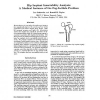Free Online Productivity Tools
i2Speak
i2Symbol
i2OCR
iTex2Img
iWeb2Print
iWeb2Shot
i2Type
iPdf2Split
iPdf2Merge
i2Bopomofo
i2Arabic
i2Style
i2Image
i2PDF
iLatex2Rtf
Sci2ools
ICRA
1993
IEEE
1993
IEEE
Hip Implant Insertability Analysis: A Medical Instance of the Peg-In-Hole Problem
cavity Recent advan.cesin cementless hip replacement surgery have significantly improved the accuracy of bone cavity preparation and custom implant shape design. With the increased accuracy and tighter fit, determining whether the implant can actually be inserted to its final working position inside ihe cavity during surgery is essential to guarantee full implant functionality. This paper presents an implemented algorithm for determining if an implant can be successfully inserted into a cavity. The program computes an insertion trajectory consisting of small implant motion steps. Motion steps are computed by solving a series of linear optimization problems whose solution corresponds to the maximum allowed displacement in a preferred direction satisfying localized motion constraints. The program implements a greedy, search-free algorithm to find a monotone trajectory in a preferred direction to any desired resolution. The program has been successfully tested on real cases.
| Added | 08 Aug 2010 |
| Updated | 08 Aug 2010 |
| Type | Conference |
| Year | 1993 |
| Where | ICRA |
| Authors | Leo Joskowicz, Russell H. Taylor |
Comments (0)

